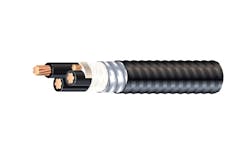Equipment Grounding Conductors and Voltage Drop
Currently, manufacturers of multi-conductor cable assemblies such as Type TC and MC cables include a standard size of equipment grounding conductor (EGC) with a given size of ungrounded conductor, as per UL standards. However, if the ungrounded conductors are increased due to voltage drop, you lose the curve that is built into NEC Table 250.122 for reducing the size of EGCs due to 250.122(B). Section 250.122(B) requires that if the ungrounded conductors are increased in size for voltage drop, the EGC needs to be increased in size too, proportionately.
For example, a 50A overcurrent protective device (OCPD) on a circuit normally requires an 8 AWG, Type XHHW, copper (75°C) conductor (minimum), per Table 310.15(B)(16). Let’s say the ungrounded conductors are increased to a 2 AWG, Type XHHW, copper conductor due to voltage drop. We can calculate a change ratio for 2 AWG to 8 AWG as follows:
66,360 cm ÷ 16,510 cm = 4.02
For a 50A OCPD, according to Table 250.122, a 10AWG was originally acceptable for use as the EGC. However, you must now increase the size based on the following calculation:
10,380 cm (the size of a 10 AWG conductor) x 4.02 (the ratio found above) = 41,721 cm
Now the EGC needs to be sized to meet this figure. A check of the table reveals we now need a 4 AWG, copper conductor (minimum).
This won’t be an issue when installing raceways with single conductor wire. However, with multi-conductor cables, the standard EGC that is manufactured with a 2 AWG cable is a 6 AWG.
This is a fairly typical problem in industrial plants today when using multi-conductor cables. While it doesn’t meet NEC requirements, it’s been my observation that the proportion calculation rule specified in 250.122(B) typically isn’t currently being adhered to because it requires special cables to be ordered — or possibly the use of a four conductor cable with the EGC being sized equivalent to the ungrounded conductors and marked as an EGC.
This proportional calculation requirement creates other issues as well. In cases where four insulated conductors are required, plus an EGC, special cable has to be ordered. Special ordered cable is very expensive and may not be listed. In addition, special order cable typically requires special production runs (i.e., schedules), which may delay the project schedule. There are also typically minimum order sizes for special cables. The cable manufacturer may be willing to make you a special cable, but there may be a minimum length of say 20,000 ft, when you really only need 5,000 ft.
Hopefully, this issue will be addressed in future editions of the NEC. Several proposals have been made in the past to remedy this conflict, but as of yet, none of them has made it through the full Code-making process. Currently, this issue is on the list of items to be looked at by the NFPA Electrical Safety Research Advisory Committee.
© 2015 Fluor Corporation. All Rights Reserved.
About the Author
Eddie Guidry
Senior Fellow
Eddie Guidry is a senior fellow with Fluor Enterprises, Inc., Sugar Land, Texas. He is highly skilled in electrical and control systems for industrial construction, design, and engineering (both domestic and abroad). The majority of Eddie’s 38 years of experience includes upstream and downstream portions of petrochemical plants and refineries. He is also heavily experienced in water and wastewater treatment facilities. Eddie is very active in the development of U.S. national (ANSI) and international codes and standards, and has been a principal member of the National Fire Protection Association (NFPA) National Electrical Code (NEC) committee since 1999 and NFPA’s National Advisory Committee on Electrical Safety Research since 2008. Eddie, who has also developed and conducted many electrical courses and seminars over the years, currently holds the corporate Master Electrician license for Fluor Corporation in the State of Texas and is also an ICC/IAEI certified electrical inspector.
